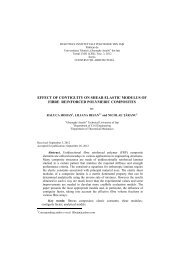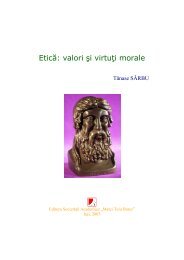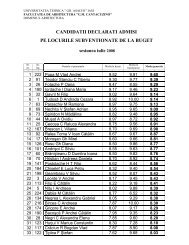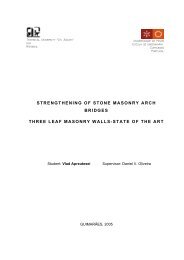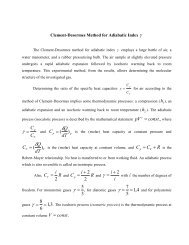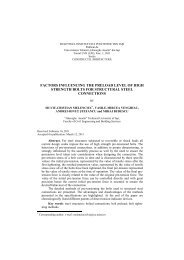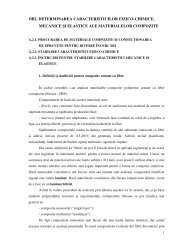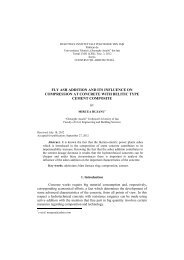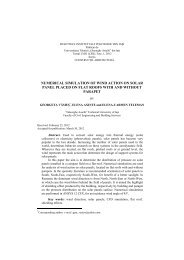1. What Are Minerals?
1. What Are Minerals?
1. What Are Minerals?
Create successful ePaper yourself
Turn your PDF publications into a flip-book with our unique Google optimized e-Paper software.
<strong>1.</strong> <strong>What</strong> are minerals?<br />
MINERALS<br />
<strong>Minerals</strong> are:<br />
<strong>1.</strong> Naturally occurring<br />
2. Inorganic<br />
3. Solids<br />
4. <strong>Minerals</strong> have a definite chemical composition<br />
5. <strong>Minerals</strong> have an orderly internal crystal structure<br />
Substances that are "mineral-like" but don't meet this definition are classified as<br />
"mineraloids". <strong>Minerals</strong> range in composition from pure elements (carbon and<br />
metals) or salts, to highly complex silicates (emeralds, tourmaline, etc.).<br />
<strong>Minerals</strong> come from the earth. <strong>Minerals</strong> are the building blocks of rocks. There are<br />
more than 2,500 different minerals. However, only about 100 minerals are<br />
commonly found. <strong>Minerals</strong> Presentation\MINERALE_MINERALS.ppt<br />
<strong>Minerals</strong> are only found in nature. They cannot be made by humans. Samples of the<br />
same type of mineral found in different places will be made up of exactly the same<br />
elements.<br />
Elements make up all matter. Of the 109 elements, only 8 make up almost all the<br />
minerals on Earth. These elements are: oxygen, calcium, sodium, iron, silicon,<br />
aluminium, magnesium, and potassium.<br />
2. Physical Properties of <strong>Minerals</strong><br />
Each mineral has different physical and chemical properties which allow it to be<br />
identified. Physical properties use to identify the minerals include colour, hardness,<br />
luster, cleavage, magnetism, reaction to acid, etc.<br />
86
<strong>Minerals</strong><br />
<strong>1.</strong> Colour - The colour of the mineral as it appears in reflected light to the naked<br />
eye.<br />
A mineral can occur in different colours. This may be caused by the addition of a<br />
particular trace element or by structural irregularities that cause it to absorb and<br />
transmit particular wavelengths of light. Such slightly different versions of a<br />
mineral or gemstone are called varieties. For instance, the mineral beryl comes in a<br />
number of colours - colourless, pink, yellow, orange, red, blue and intense green,<br />
each with a different variety name. The intense green variety is called “emerald”,<br />
the blue, “aquamarine” and the pink “morganite”.<br />
2. Lustre - The character of the light reflected from the mineral. A mineral may<br />
have a metallic lustre (in other words, it’s a metal), or a non-metallic lustre.<br />
Non-metallic lustres may be described as:<br />
glassy or vitreous<br />
dull<br />
pearly<br />
resinous<br />
waxy<br />
adamantine<br />
silky<br />
3. Hardness - The resistance of a mineral to scratching. Hardness is measured on a<br />
scale of 1-10 called Mohs Hardness Scale. In lab, we express hardness in<br />
comparison to common objects (fingernail, copper penny, nail, glass).<br />
The table below is a universally accepted standard of the comparative hardness of<br />
minerals. It’s the Mohs' scale, after Frederich Mohs, the mineralogist who devised<br />
it. The range is from the softest mineral (talc) to the hardest (diamond).<br />
87
<strong>Minerals</strong><br />
<strong>1.</strong> Talc<br />
2. Gypsum<br />
________ fingernail<br />
3. Calcite<br />
________ penny (copper)<br />
4. Fluorite<br />
_________ nail<br />
5. Apatite<br />
_________ glass<br />
6. Orthoclase feldspar (K feldspar)<br />
7. Quartz<br />
8. Topaz<br />
9. Corundum<br />
10. Diamond<br />
4. Cleavage - the tendency of a mineral to break along flat surfaces related to<br />
planes of weakness in its crystal structure. <strong>Minerals</strong> can be identified by the<br />
number of cleavage planes they exhibit, and the angles between them. For<br />
example, some minerals tend to cleave or break into flat sheets (the micas:<br />
muscovite and biotite), other break into cubes (halite), or into rhombus (calcite<br />
and dolomite). Other minerals have different types of cleavage.<br />
5. Fracture - irregular breakage not related to planes of weakness in the mineral.<br />
Some minerals, such as quartz and olivine do not have cleavage. They have<br />
instead a special type of breakage called conchoidal fracture. Conchoidal<br />
fracture produces curved breakage surfaces.<br />
6. Magnetism - A few minerals are magnetic - that is, they are attracted to a<br />
magnet, or they act as a natural magnet, attracting small steel objects.<br />
7. Reaction to acid - The carbonate minerals react with dilute hydrochloric acid<br />
(HCl) by fizzing, producing bubbles of carbon dioxide gas (the same type of<br />
harmless gas bubbles that are found in carbonated beverages). Calcite fizzes<br />
readily in hydrochloric acid. Dolomite will fizz if it is first scratched and<br />
powdered.<br />
<strong>Minerals</strong> form crystals in one of seven crystal systems. Crystals can be very large.<br />
Others are too small to see without powerful magnification. Some mineral crystals<br />
reveal variations at different stages of their growth by colour banding or zoning.<br />
88
<strong>Minerals</strong><br />
3. How are minerals made?<br />
<strong>Minerals</strong> grow in a wide variety of geological environments - salt lakes, deep<br />
oceans, volcanoes, and cooling deep masses of molten rock. They can also grow<br />
under the influence of heat and/or pressure, and from solutions and gases carrying<br />
concentrations of certain elements. Usually, minerals grow when solutions or gases<br />
rich in certain elements cool or evaporate, molten rock cools, or heat and/or<br />
pressure change (re-organise) pre-existing chemicals.<br />
4. How do we identify minerals?<br />
Some minerals are instantly recognizable because of their unique colour or shape,<br />
but usually some simple non-destructive tests can be done to prove the identity of<br />
the most common minerals present. These tests include those for the crystal system<br />
(based on symmetry), colour, lustre, transparency, cleavage, fracture, streak colour,<br />
refractive index, ultra-violet fluorescence, magnetism, radioactivity, specific<br />
gravity, melting (fusion) and simple chemical tests. Sometimes more complex tests<br />
are necessary, involving complex and expensive analytical instruments which use<br />
X-rays, such as the X-ray Diffractometer (analyses crystal structure) and Electron<br />
Microprobe or Energy Dispersive Spectrometer (analyses chemical contents).<br />
5. Mineral Classification by Chemical Composition<br />
<strong>Minerals</strong> are categorized according to their chemical composition or "mineral<br />
class". There are eight mineral classes which are categorized by anion (negative<br />
ion) group.<br />
5.<strong>1.</strong> Class 1: Native elements<br />
Apart from the free gases in the Earth’s atmosphere, some 20 elements occur in<br />
nature in a pure (uncombined) or nearly pure form. Known as the native elements,<br />
they are partitioned into three families: metals, semimetals, and non-metals.<br />
The most common native metals, which are characterized by simple crystal<br />
structures, make up three groups: the gold group, consisting of gold, silver, copper,<br />
and lead; the platinum group, composed of platinum, palladium, iridium, and<br />
osmium; and the iron group, containing iron and nickel-iron. Mercury, tantalum,<br />
tin, and zinc are other metals that have been found in the native state.<br />
The native semimetals are divided into two isostructural groups (those whose<br />
members share a common structure type): (1) antimony, arsenic, and bismuth, with<br />
89
<strong>Minerals</strong><br />
the latter two being more common in nature, and (2) the rather uncommon<br />
selenium and tellurium. Carbon, in the form of diamond and graphite, and sulphur<br />
are the most important native non-metals. Diamonds\Diamonds2.ppt<br />
5.<strong>1.</strong><strong>1.</strong> Metals<br />
Gold, silver, and copper are members of the same group (column) in the periodic<br />
table of elements and therefore have similar chemical properties. In the<br />
uncombined state, their atoms are joined by the fairly weak metallic bond. These<br />
minerals share a common structure type, and their atoms are positioned in a simple<br />
cubic closest-packed arrangement.<br />
Owing to their similar crystal structure, the members of the gold group display<br />
similar physical properties. All are rather soft, ductile, and malleable; gold, silver,<br />
and copper serve as excellent conductors of electricity and heat and exhibit metallic<br />
lustre and hackly fracture. These properties are attributable to their metallic<br />
bonding. The gold-group minerals crystallize in the isometric system and have high<br />
densities as a consequence of cubic closest packing.<br />
The platinum group also includes the rarer mineral alloys platiniridium and<br />
iridosmine. The members of this group are harder than the metals of the gold group<br />
and also have higher melting points.<br />
The iron-group metals are isometric and have a simple cubic packed structure. Its<br />
members include pure iron, which is rarely found on the surface of the Earth, and<br />
two species of nickel-iron (kamacite and taenite), which have been identified as<br />
common constituents of meteorites. The terrestrial core is thought to be composed<br />
largely of such iron-nickel alloys.<br />
5.<strong>1.</strong>2. Semimetals<br />
The semimetals antimony, arsenic, and bismuth have a structure type distinct from<br />
the simple-packed spheres of the metals. In these semimetals, each atom is<br />
positioned closer to three of its neighbouring atoms than to the rest.<br />
The covalent character of the bonds joining the four closest atoms is linked to the<br />
electronegative nature of the semimetals, reflected by their position in the periodic<br />
table. Members of this group are fairly brittle, and they do not conduct heat and<br />
electricity nearly as well as the native metals. The bond type suggested by these<br />
properties is intermediate between metallic and covalent; it is consequently<br />
90
<strong>Minerals</strong><br />
stronger and more directional than pure metallic bonding, resulting in crystals of<br />
lower symmetry.<br />
5.<strong>1.</strong>3. Non-metals<br />
The native non-metals diamond, graphite, and sulphur are structurally distinct from<br />
the metals and semimetals. The structure of sulphur, usually orthorhombic in form,<br />
may contain limited solid solution by selenium.<br />
The polymorphs of carbon, graphite and diamond display dissimilar structures,<br />
resulting in their differences in hardness and specific gravity. In diamond, each<br />
carbon atom is bonded covalently in a tetrahedral arrangement, producing a<br />
strongly bonded and exceedingly close-knit but not closest-packed structure. The<br />
carbon atoms of graphite, however, are arranged in six-member rings in which each<br />
atom is surrounded by three close-by neighbours located at the vertices of an<br />
equilateral triangle. The rings are linked to form sheets that are separated by a<br />
distance exceeding one atomic diameter. Van der Waals forces act perpendicular to<br />
the sheets, offering a weak bond, which, in combination with the wide spacing,<br />
leads to perfect basal cleavage and easy gliding along the sheets.<br />
5.2. Class 2: Sulphides<br />
This important class includes most of the ore minerals. The similar but rarer<br />
sulpharsenides are grouped here as well. Sulphide minerals consist of one or more<br />
metals combined with sulphur; sulpharsenides contain arsenic replacing some of<br />
the sulphur.<br />
Sulphides are generally opaque and exhibit distinguishing colours and streaks.<br />
(Streak is the colour of a mineral’s powder.) The no opaque varieties (cinnabar,<br />
realgar, and orpiment) possess high refractive indices, transmitting light only on the<br />
thin edges of a specimen.<br />
Few broad generalizations can be made about the structures of sulphides, although<br />
these minerals can be classified into small groups according to similarities in<br />
structure. Ionic and covalent bonding are found in many sulphides, while metallic<br />
bonding is apparent in others as evidenced by their metal properties. The simplest<br />
and most symmetric sulphide structure is based on the architecture of the sodium<br />
chloride structure.<br />
91
5.3. Class 3: Sulphosalts<br />
<strong>Minerals</strong><br />
There are approximately 100 species constituting the rather large and very diverse<br />
sulphosalt class of minerals.<br />
The sulphosalts differ notably from the sulphides and sulpharsenides with regard to<br />
the role of semimetals, such as arsenic (As) and antimony (Sb), in their structures.<br />
In the sulpharsenides, the semimetals substitute for some of the sulphur in the<br />
structure, while in the sulphosalts they are found instead in the metal site.<br />
5.4. Class 4: Oxides and hydroxides<br />
This class consists of oxygen-bearing minerals; the oxides combine oxygen with<br />
one or more metals, while the hydroxides are characterized by hydroxyl (OH) -<br />
groups.<br />
The oxides are further divided into two main types: simple and multiple. Simple<br />
oxides contain a single metal combined with oxygen in one of several possible<br />
metal: oxygen ratios (X:O): XO, X2O, X2O3, etc. Ice, H2O, is a simple oxide of the<br />
X2O type that incorporates hydrogen as the cation. Although SiO2 (quartz and its<br />
polymorphs) is the most commonly occurring oxide, it is discussed below in the<br />
section on silicates because its structure more closely resembles that of other<br />
silicon-oxygen compounds. Two nonequivalent metal sites (X and Y) characterize<br />
multiple oxides, which have the form XY2O4.<br />
Unlike the minerals of the sulphide class, which exhibit ionic, covalent, and<br />
metallic bonding, oxide minerals generally display strong ionic bonding. They are<br />
relatively hard, dense, and refractory. These minerals generally occur in small<br />
amounts in igneous and metamorphic rocks and also as preexisting grains in<br />
sedimentary rocks.<br />
5.5. Class 5: Halides<br />
Members of this class are distinguished by the large-sized anions of the halogens<br />
chlorine, bromine, iodine, and fluorine. The ions carry a charge of negative one and<br />
easily become distorted in the presence of strongly charged bodies. When<br />
associated with rather large, weakly polarizing cations of low charge, such as those<br />
of the alkali metals, both anions and cations take the form of nearly perfect spheres.<br />
Structures composed of these spheres exhibit the highest possible symmetry.<br />
92
<strong>Minerals</strong><br />
The halides manifest relatively low hardness and moderate-to-high melting points.<br />
In the solid state they are poor thermal and electric conductors, but when molten<br />
they conduct electricity well.<br />
Halogen ions may also combine with smaller, more strongly polarizing cations than<br />
the alkali metal ions. Lower symmetry and a higher degree of covalent bonding<br />
prevail in these structures. Water and hydroxyl ions may enter the structure.<br />
The halides consist of about 80 chemically related minerals with diverse structures<br />
and widely varied origins. The most common are halite (NaCl) and fluorite (CaF2).<br />
5.6. Class 6: Carbonates<br />
The carbonate minerals contain the anionic complex (CO3) 2- , which is triangular in<br />
its coordination, with a carbon atom at the centre and an oxygen atom at each of the<br />
corners of an equilateral triangle. These anionic groups are strongly bonded,<br />
individual units and do not share oxygen atoms with one another. The triangular<br />
carbonate groups are the basic building units of all carbonate minerals and are<br />
largely responsible for the properties particular to the class.<br />
Carbonates are frequently identified using the effervescence test with acid. The<br />
reaction that results in the characteristic fizz, 2H + + CO 2− /3 → H2O + CO2, makes<br />
use of the fact that the carbon-oxygen bonds of the CO3 groups are not quite as<br />
strong as the corresponding carbon-oxygen bonds in carbon dioxide.<br />
The common anhydrous carbonates are divided into three groups that differ in<br />
structure type: calcite, aragonite, and dolomite. The copper carbonates azurite and<br />
malachite are the only notable hydrous varieties.<br />
Members of the calcite group exhibit perfect rhombohedra cleavage. The<br />
composition CaCO3 most commonly occurs in two different polymorphs:<br />
rhombohedra calcite with calcium surrounded by six closest oxygen atoms and<br />
orthorhombic aragonite with calcium surrounded by nine closest oxygen atoms.<br />
The aragonite group displays more limited solid solution than the calcite group.<br />
The type of cation present in aragonite minerals is largely responsible for the<br />
differences in physical properties among the members of the group. Specific<br />
gravity, for example, is roughly proportional to the atomic weight of the metal ions.<br />
The dolomite structure can be considered as a calcite-type structure in which<br />
magnesium and calcium cations occupy the metal sites in alternate layers. The<br />
93
<strong>Minerals</strong><br />
calcium (Ca 2+ ) and magnesium (Mg 2+ ) ions differ in size by 33 percent, and this<br />
produces cation ordering with the two cations occupying specific and separate<br />
levels in the structure.<br />
5.7. Class 7: Nitrates<br />
The nitrates are characterized by their triangular (NO3) - groups that resemble the<br />
(CO3) 2- groups of the carbonates, making the two mineral classes similar in<br />
structure. The nitrogen cation (N 5+ ) carries a high charge and is strongly polarizing<br />
like the carbon cation (C 4+ ) of the CO3 group. A tightly knit triangular complex is<br />
created by the three nitrogen-oxygen bonds of the NO3 group; these bonds are<br />
stronger than all others in the crystal.<br />
5.8. Class 8: Borates<br />
<strong>Minerals</strong> of the borate class contain boron-oxygen groups that can link together, in<br />
a phenomenon known as polymerization, to form chains, sheets, and isolated<br />
multiple groups. The silicon-oxygen (SiO4) tetrahedrons of the silicates polymerize<br />
in a manner similar to the (BO3) 3- triangular groups of the borates. A single oxygen<br />
atom is shared between two boron cations (B 3+ ), thereby linking the BO3 groups<br />
into extended units such as double triangles, triple rings, sheets, and chains. The<br />
oxygen atom is able to accommodate two boron atoms because the small boron<br />
cation has a bond strength to each oxygen that is exactly one-half the bond energy<br />
of the oxygen ion.<br />
94



